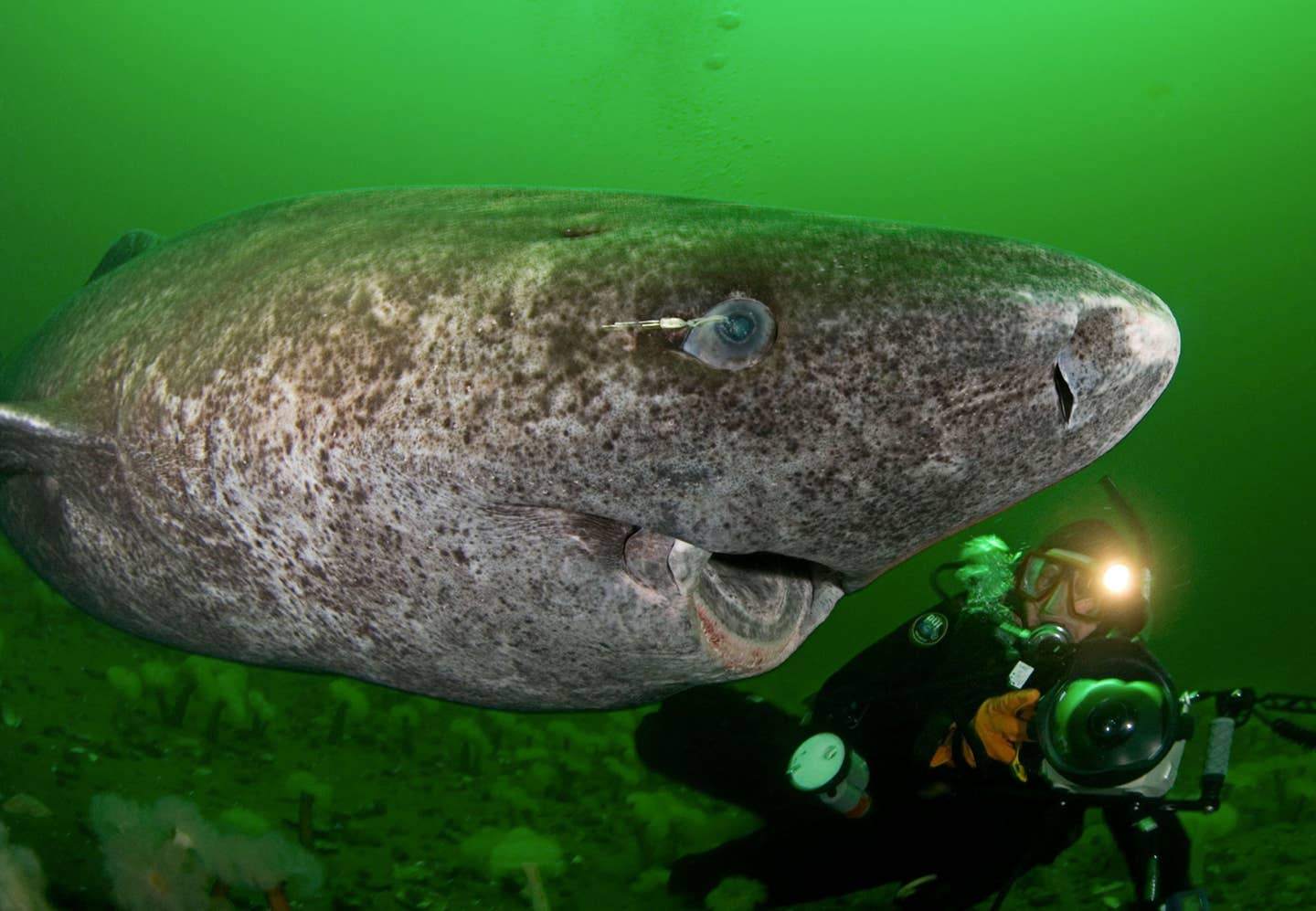Scientists discover 500-year-old shark, Earth’s longest living vertebrate
The Greenland shark holds the title as the longest-lived vertebrate on Earth, with some individuals potentially reaching 500 years of age.

Greenland sharks, native to the cold, stable waters of the North Atlantic and Arctic, exhibit slow growth, adding only a few centimeters annually. (CREDIT: CC BY-SA 4.0)
The Greenland shark holds the title as the longest-lived vertebrate on Earth, with some individuals potentially reaching 500 years of age. This elusive deep-sea predator, found in the frigid waters of the North Atlantic and Arctic Oceans, has fascinated scientists due to its remarkable lifespan. Its slow growth rate and mysterious biology have made it a subject of ongoing research, shedding light on how some species defy the limits of aging.
A major breakthrough in understanding the longevity of Greenland sharks came from a research team led by Julius Nielsen, a marine biologist at the University of Copenhagen. Nielsen and his colleagues conducted a study that revealed a Greenland shark estimated to be at least 272 years old, with some models suggesting an upper age limit of nearly 500 years.
This finding shattered previous records, surpassing the known lifespan of the 211-year-old bowhead whale, which had long been considered the longest-lived vertebrate.
Determining the age of Greenland sharks posed a significant challenge for researchers. Many fish species can be aged by counting growth layers in small calcium carbonate structures, called otoliths, found in their ears. These layers function much like tree rings, providing a timeline of growth. However, sharks lack these ear stones, making traditional aging techniques ineffective. Additionally, Greenland sharks have minimal calcified structures, further complicating the process.
To overcome this obstacle, scientists turned to a different method—examining the lenses in the sharks’ eyes. The eye lens is composed of proteins that remain unchanged after forming, allowing researchers to use them as a biological timestamp. Since the innermost proteins develop while the shark is still in its mother’s womb, their age can be determined using radiocarbon dating techniques.
By analyzing these proteins, researchers were able to estimate the ages of several Greenland sharks, confirming their extraordinary lifespans.
The study provided groundbreaking insights into deep-sea longevity and raised new questions about how these sharks manage to live for centuries. Their slow metabolism and cold-water habitat likely play crucial roles in their extended lifespan, but much about their biology remains unknown.
This discovery has broader implications beyond marine biology, offering insights into aging and longevity that could inform human medical research. By understanding how Greenland sharks delay aging and resist disease, scientists may uncover new approaches to extending health and lifespan in other species, including humans.
Related Stories:
To do this, scientists used radiocarbon dating. This method measures the levels of carbon-14, a type of carbon that decays over time. By applying this technique to the proteins at the center of each lens, scientists were able to estimate a broad age range for each shark.
One shark, measuring five meters, was found to be at least 272 years old, with an upper age estimate of more than 500 years (392 +/- 120 years). Another specimen was at least 260 years old, potentially exceeding 400 years. “We definitely expected the sharks to be old, but we didn’t expect that it would be the longest-living vertebrate animal,” Nielsen said.
These sharks inhabit the cold, stable environments of the North Atlantic and Arctic surface waters, growing just a few centimeters each year. Despite their slow growth rate, they can reach over five meters in length and often serve as apex predators in their ecosystem.
Aging Greenland sharks was once considered impossible. Other fish species are aged by measuring calcareous bodies in their ears, but Greenland sharks lack these hard-boned structures, as their skeletons are made of cartilage.
Instead, Nielsen and his team examined the radiation in the sharks’ eyes. During the 1950s and '60s, nuclear bomb tests introduced radioactive particles into the atmosphere, which were then absorbed by living organisms, including the sharks.
Greenland sharks have unique eye lens tissue that remains unchanged throughout their lives, preserving historic radiation. This eye lens is composed of specialized material with metabolically inert proteins, meaning once synthesized, they are not renewed. By isolating the tissue formed when the shark was a pup, the researchers performed radiocarbon dating to estimate ages.
For the study, the team examined 28 sharks that had died after being caught as by-catch in fishing nets. While there is some uncertainty in the age estimates, Nielsen stated that the most likely age for the oldest shark was about 390 years, with a 95 percent certainty range of 272 to 512 years.
Steven Austad, an aging biology expert at the University of Alabama, Birmingham, remarked, “It’s a fascinating paper and certainly moves back the vertebrate longevity record by a substantial amount. Even at the low end of their estimate—272 years—that’s still substantially longer than any other documented vertebrate.”
These findings have significant implications for the conservation of Greenland sharks. The team believes these sharks reach sexual maturity only when they are around four meters long, which could take about 150 years.
This extreme longevity suggests that Greenland sharks might still be recovering from overfishing that occurred before World War II. “When you evaluate the size distribution all over the North Atlantic, it is quite rare that you see sexually mature females, and quite rare that you find newborn pups or juveniles,” Nielsen explained.
Most of the sharks observed are sub-adults, likely a result of historical overfishing. The older, sexually mature sharks are no longer present in large numbers, and there aren’t enough mature individuals to produce new generations. While there is still a significant population of ‘teenagers’, it will take another century for them to become sexually active.
This study not only reveals the incredible longevity of Greenland sharks but also underscores the vulnerability of nature to human activities. The findings highlight the importance of conservation efforts to protect these ancient creatures and their ecosystems. As you explore the natural world, studies like this remind you of the delicate balance needed to sustain such remarkable life forms.
Other long living vertebrates
The longest-living vertebrates are fascinating for their exceptional lifespans, which often surpass those of most animals, including humans. Aside from the Greenland shark, here are some of the other longest-living vertebrates:
Bowhead Whale (Balaena mysticetus):
Known for living in Arctic and sub-Arctic waters, bowhead whales have impressive lifespans of over 200 years. One of the reasons for their longevity might be their slow metabolic rate. These whales are also known for their resilience to cancer and other age-related diseases.
Koi Fish (Cyprinus rubrofuscus):
Some species of koi can live for over 200 years. One of the most famous koi fish, named Hanako, reportedly lived for 226 years. These long-lived fish are well-known in Japanese culture.
Aldabra Giant Tortoise (Aldabrachelys gigantea):
Giant tortoises, like those from the Aldabra Atoll, can live well over 150 years. One well-known tortoise, named Adwaita, lived to be about 255 years old, although this estimate is debated.
Rougheye Rockfish (Sebastes aleutianus):
These fish, found in the North Pacific Ocean, can live for more than 200 years. They are one of the longest-living marine species, and their slow growth and long lifespan help them adapt to deep ocean environments.
Red Sea Urchin (Mesocentrotus franciscanus):
While not a vertebrate, it's worth mentioning because it can live more than 200 years. Though sea urchins are invertebrates, they contribute to our understanding of longevity in marine species.
These animals share certain characteristics that contribute to their longevity, including slow metabolism, cold or stable environments, and evolutionary adaptations for repair mechanisms, especially in DNA.
Note: Materials provided above by The Brighter Side of News. Content may be edited for style and length.
Like these kind of feel good stories? Get The Brighter Side of News' newsletter.
Rebecca Shavit
Science & Technology Journalist | Innovation Storyteller
Based in Los Angeles, Rebecca Shavit is a dedicated science and technology journalist who writes for The Brighter Side of News, an online publication committed to highlighting positive and transformative stories from around the world. With a passion for uncovering groundbreaking discoveries and innovations, she brings to light the scientific advancements shaping a better future. Her reporting spans a wide range of topics, from cutting-edge medical breakthroughs and artificial intelligence to green technology and space exploration. With a keen ability to translate complex concepts into engaging and accessible stories, she makes science and innovation relatable to a broad audience.



